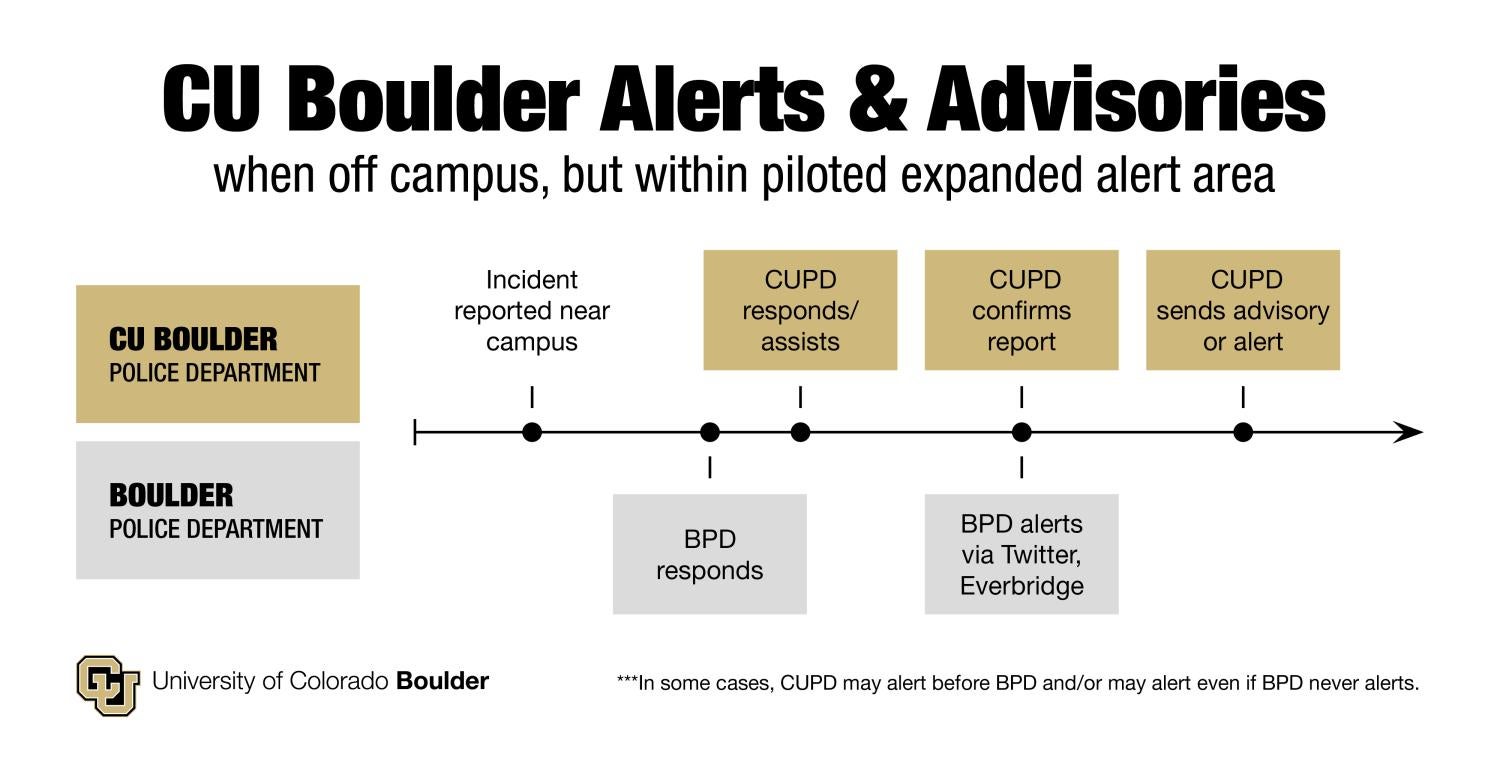The campus’s new practice of alerting stakeholders to off-campus incidents can raise questions about the nature, reasoning and terminology of notifications, as evidenced this week. Here is a list of common emergency definitions and a Q&A with University of Colorado Boulder Police Department (CUPD) Chief Doreen Jokerst on alert notification levels, as well as how the university responds to off-campus incidents.
How does CU Boulder keep campus stakeholders informed of off-campus incidents?
When a life-threatening incident occurs off campus in heavily student-populated areas, and university police can confirm details with Boulder police, those registered to receive the university’s emergency notifications will get updates from campus as part of CU Boulder’s newly expanded alert zones. Typically, the lead agency will alert the community first through its own notification systems.
The expansion encompasses areas near campus that are outside the geography for which the university is required to send emergency notifications as defined by the Clery Act but dense with student populations.
The expanded alert area, currently in a trial phase, includes the University Hill neighborhood, the Goss Grove neighborhood near Folsom Street and Canyon Boulevard, the Lower Chautauqua neighborhood and the residential area north of Williams Village called Baseline Sub.
During an event, the decision to send alerts within the expanded notification boundaries will be made depending on the severity of the incident, as well as the location, distance from campus and student population density. University police will work in partnership with Boulder police to confirm and share details of off-campus incidents, including more comprehensive updates as details become available.
Learn more and view a map of the pilot expansion.
How does CU Boulder Police work with other local public safety agencies?
CUPD is a full-service public safety agency providing community-based policing 24/7, 365. We have police officers, community safety officials and residential service officers who patrol campus and support safety in our community.
We also work with Boulder Police and state and federal agencies. We have strong relationships with these public safety partners to ensure the most coordinated response and notification possible when emergencies occur. The university has opted-in all current students and employees with Boulder, Colorado, residential addresses into Everbridge, the emergency alert messaging system used by Boulder Police, Boulder Fire-Rescue, Boulder County Sheriff’s Department and Longmont Department of Public Safety.
Everbridge is used to send advisories, warnings and orders to take action during life-threatening situations such as police activity, fires, floods and other natural disasters in the city of Boulder and unincorporated Boulder county. The system also shares critical weather alerts and alerts subscribers of missing and endangered persons.
Learn more about CUPD on our website, and review CU Boulder’s alert levels and resources on the CU Boulder Alerts website.
What types of emergency alerts does CU Boulder send?
There are three levels of notification that can be sent out, depending on the nature of the emergency or situation.
The highest notification level is a CU Emergency Alert. These alerts are sent out during emergencies such as an active harmer incident or other confirmed, immediate threats posing a risk to life and safety on our campus. CU Emergency Alerts are also shared if there is a change to the university’s operating status due to weather, etc.
The next notification level is a CU Safety Alert, an email notification to the community of a crime committed on or near campus (per Clery Act guidelines) that provides increased community awareness of ongoing or dangerous situations.
The third notification level is a CU Advisory. CU advisories are for non-emergency events/incidents on campus or both emergency and non-emergency events off campus that could potentially impact campus, such as extended power failures, building evacuations, sudden road closures or other traffic/construction impacts on or near campus, as well as police activity near campus. These are shared via social media and on our alerts site. The latest alerts, including those sent this week, can be viewed on the CU Boulder Alerts site.
What if I’m not receiving CU Boulder’s text alerts?
Please ensure your contact information, including cell phone number, is up to date in the appropriate portal and confirm that you have not opted-out of receiving alerts. The CU Boulder Alerts site has step-by-step instructions to help ensure receipt of text alerts for students and employees. If you need help, email the Office of Information Technology.

Image showing the flow of information during incidents occurring off campus. When an incident is reported near campus, Boulder Police respond and CU Boulder Police assist. Boulder Police may alert the community via Twitter or Everbridge, while CU Boulder Police confirm information then send an advisory or emergency alert.




